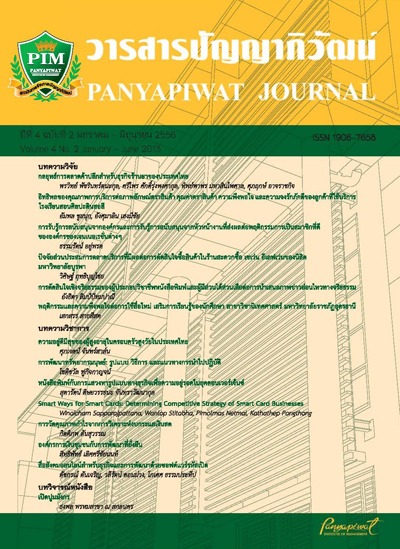อิทธิิพลของคุณภาพการบริการต่อภาพลักษณ์ตราสินค้าคุณค่าตราสินค้าความพึงพอใจ และความจงรักภักดี ของลูกค้าที่ใช้บริการโรงเรียนศิลปะดินสอสี
Main Article Content
บทคัดย่อ
ผลการวิจัยแสดงว่าโมเดลความสัมพันธ์เชิงสาเหตุอิทธิพลของคุณภาพการบริการต่อภาพลักษณ์ตราสินค้า คุณค่าตราสินค้า ความพึงพอใจ และความจงรักภักดีของลูกค้าที่ใช้บริการโรงเรียนสอนศิลปะดินสอสีมีความสอดคล้องกับข้อมูลเชิงประจักษ์อยู่ในเกณฑ์ดีค่าไค-สแควร์ เท่ากับ 493.647 ที่องศาอิสระ (df) 474 ค่าความน่าจะเป็น (p-value) เท่ากับ 0.257 ไค-สแควร์สัมพัทธ์(c2/df) เท่ากับ 1.041 ค่าดัชนีวัดระดับความกลมกลืน (GFI) เท่ากับ 0.938 ค่าดัชนีวัดระดับความกลมกลืนที่ปรับแก้ (AGFI) เท่ากับ 0.902 ค่าดัชนีวัดระดับความสอดคล้องเปรียบเทียบ (CFI) เท่ากับ 0.998 และค่าดัชนีค่าความคลาดเคลื่อนในการประมาณค่าพารามิเตอร์ (RMSEA) เท่ากับ 0.014 นอกจากนี้ผลการวิจัยยังพบว่า (1) คุณภาพการบริการในมิติสิ่งที่สัมผัสได้มีอิทธิพลทางบวกต่อคุณค่าตราสินค้า (2) คุณภาพการบริการในมิติความเชื่อถือและไว้วางใจมีอิทธิพลทางบวกต่อภาพลักษณ์ตราสินค้า (3) คุณภาพการบริการในมิติการเอาใจใส่ลูกค้าเป็นรายบุคคลมีอิทธิพลทางบวกต่อภาพลักษณ์ตราสินค้า (4) ภาพลักษณ์ตราสินค้ามีอิทธิพลทางบวกต่อคุณค่าตราสินค้า (5) ภาพลักษณ์ตราสินค้ามีอิทธิพลทางบวกต่อความพึงพอใจของลูกค้า (6) คุณค่าตราสินค้ามีอิทธิพลทางบวกต่อความพึงพอใจของลูกค้า (7) คุณค่าตราสินค้ามีอิทธิพลทางบวกต่อความจงรักภักดีของลูกค้าและ (8) ความพึงพอใจของลูกค้ามีอิทธิพลทางบวกต่อความจงรักภักดีของลูกค้า
The objectives of this research were to develop and validate a causal relationship model of Influence of Service Quality on Brand Image, Brand Equity, Customer Satisfaction and Customer Loyalty of Din Sor See Art School. The model involved nine latent variables: service quality which consist of tangible, reliability, responsiveness, assurance, and empathy, brand image, brand equity, customer satisfaction and customer loyalty. The researchers used quantitative methods which involved empirical research. The research tool was a questionnaire to collect data from 192 customers of Din Sor See Art School.The statistics used in data analysis were frequency, mean, and structural equation model analysis.
It was found that the model was consistent with the empirical data. Goodness of fit measures were found to be: Chi-square 493.647 (df=474, p-value=0.257); Relative Chi-square (c2/df) 1.041; Goodness of Fit Index (GFI) 0.938; Adjusted Goodness of Fit Index (AGFI) 0.902; Comparative Fit Index (CFI) 0.998; and Root Mean Square Error of Approximation (RMSEA) 0.014.It was also found that (1) Service quality in the dimension of tangible had a positive and direct influence on brand equity (2) Service quality in the dimension of reliability had a positive and direct influence on brand image (3) Service quality in the dimension of empathy had a positive and direct influence on brand image (4) Brand image had a positive and direct influence on brand equity (5) Brand image had a positive and direct influence on customer satisfaction (6) Brand equity had a positive and direct influence on customer satisfaction (7) Brand equity had a positive and direct influence on customer loyalty and (8) Customer satisfaction had a positive and direct influence on customer loyalty.
Article Details
“ข้าพเจ้าและผู้เขียนร่วม (ถ้ามี) ขอรับรองว่า บทความที่เสนอมานี้ยังไม่เคยได้รับการตีพิมพ์และไม่ได้อยู่ระหว่างกระบวนการพิจารณาลงตีพิมพ์ในวารสารหรือแหล่งเผยแพร่อื่นใด ข้าพเจ้าและผู้เขียนร่วมยอมรับหลักเกณฑ์การพิจารณาต้นฉบับ ทั้งยินยอมให้กองบรรณาธิการมีสิทธิ์พิจารณาและตรวจแก้ต้นฉบับได้ตามที่เห็นสมควร พร้อมนี้ขอมอบลิขสิทธิ์บทความที่ได้รับการตีพิมพ์ให้แก่สถาบันการจัดการปัญญาภิวัฒน์หากมีการฟ้องร้องเรื่องการละเมิดลิขสิทธิ์เกี่ยวกับภาพ กราฟ ข้อความส่วนใดส่วนหนึ่งและ/หรือข้อคิดเห็นที่ปรากฏในบทความข้าพเจ้าและผู้เขียนร่วมยินยอมรับผิดชอบแต่เพียงฝ่ายเดียว”
References
สุภมาส อังสุโชติ สมถวิล วิจิตรวรรณา และรัชนีกูล ภิญโญภานุวัฒน์. (2552). สถิติวิเคราะห์สําหรับการวิจัยทางสังคมศาสตร์และพฤติกรรมศาสตร์: เทคนิคการใช้โปรแกรม LISREL พิมพ์ครั้งที่ 2. กรุงเทพฯ: เจริญดีมั่งคงการพิมพ์.
เสรี ชัดแช้ม. (2546). โมเดลสมการโครงสร้าง, วารสารวิจัยและวัดผลการศึกษา, 1(1), 1-24.
อัมพล ชูสนุก และกุสุมา ประไพพักตร์. (2554). โมเดลเชิงสาเหตุคุณภาพการบริการที่มีอิทธิพลต่อความพึงพอใจและความจงรักภักดีของผู้ใช้บริการสาขาของธนาคารพาณิชย์ในจังหวัดระยอง, วารสารดุษฎีบัณฑิตทางสังคมศาสตร์(ฉบับมนุษยศาสตร์และสังคมศาสตร์), 1(2), 49-60.
Barbera, N., Goodman, R. J., & Goh, B. K. (2011). Restaurant consumers repeat patronage: A service quality concern. International Journal of Hospitality Management, 30(2), 329-336.
Beristain, J. J., & PilarZorrilla. (2011). The relationship between store image and store brand equity: Aconceptual framework and evidence from hypermarkets. Journal of Retailing and Consumer Services, 18, 562-574.
Caruana, A. (2002). Service loyalty: The effect of service quality and the mediating role of customer satisfaction. European Journal of Marketing, 36(7/8), 811-828.
Chen, S.-C. (2012). The customer satisfaction-loyalty relation in an interactive e-service setting: The mediators. Journal of Retailing and Consumer Services, 19(2), 202-210.
Deng, Z., Lu, Y., Wei, K. K., & Zhang, J. (2010). Understanding customer satisfaction and loyalty:An empirical study of mobile instant messages in China. International Journal of Information Management, 30, 289-300.
Field, A. (2005). Discovering statistics using SPSS (2 ed.). Thousand Okes, CA: Sage Publications.
Forgas-Coll, S., Palau-Saumell, R., Sánchez-García, J., & Callarisa-Fiol, L. J. (2012). Urban destination loyalty drivers and cross-national moderator effects: The case of Barcelona. Tourism Management, 33, 1309-1320.

